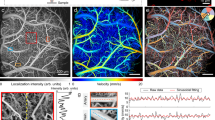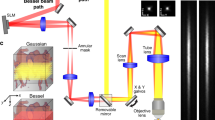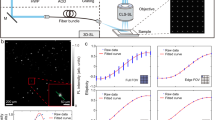Abstract
The present protocol describes a method for parallel measurement of cerebral blood flow (CBF) using fluorescent microspheres and structural assessment of the same material. The method is based on the standard microsphere technique, embolizing capillaries proportional to the blood flow, but requires dissolution of the tissue to retrieve the microspheres. To link the blood flow to the tissue morphology we modified the technique to fluorescent microspheres, which are quantified in cryo- or vibratome sections, allowing structural analysis by, for example, immunohistochemistry or standard histology. The protocol takes 8 h 50 min, without pauses, to complete, but additional flow measurements or specific protocols can increase the time needed.
This is a preview of subscription content, access via your institution
Access options
Subscribe to this journal
Receive 12 print issues and online access
$259.00 per year
only $21.58 per issue
Buy this article
- Purchase on Springer Link
- Instant access to full article PDF
Prices may be subject to local taxes which are calculated during checkout




Similar content being viewed by others
References
Rudolph, A.M. & Heymann, M.A. The circulation of the fetus in utero. Methods for studying distribution of blood flow, cardiac output and organ blood flow. Circ. Res. 21, 163–184 (1967).
Makowski, E.L., Meschia, G., Droegemueller, W. & Battaglia, F.C. Measurement of umbilical arterial blood flow to the sheep placenta and fetus in utero. Distribution to cotyledons and the intercotyledonary chorion. Circ. Res. 23, 623–631 (1968).
Kowallik, P. et al. Measurement of regional myocardial blood flow with multiple colored microspheres. Circulation 83, 974–982 (1991).
Hale, S.L., Alker, K.J. & Kloner, R.A. Evaluation of nonradioactive, colored microspheres for measurement of regional myocardial blood flow in dogs. Circulation 78, 428–434 (1988).
Glenny, R.W., Bernard, S. & Brinkley, M. Validation of fluorescent-labeled microspheres for measurement of regional organ perfusion. J. Appl. Physiol. 74, 2585–2597 (1993).
Austin, G.E. et al. Determination of regional myocardial blood flow using fluorescent microspheres. Am. J. Cardiovasc. Pathol. 4, 352–357 (1993).
Mori, H. et al. New nonradioactive microspheres and more sensitive X-ray fluorescence to measure regional blood flow. Am. J. Physiol. 263, H1946–H1957 (1992).
Morita, Y. et al. Local blood flow measured by fluorescence excitation of nonradioactive microspheres. Am. J. Physiol. 258, H1573–H1584 (1990).
Fluorescent Microsphere Resource Center. Microsphere manual http://fmrc.pulmcc.washington.edu.
De Visscher, G. et al. Development of a novel fluorescent microsphere technique to combine serial cerebral blood flow measurements with histology in the rat. J. Neurosci. Methods 122, 149–156 (2003).
Buckberg, G.D. et al. Some sources of error in measuring regional blood flow with radioactive microspheres. J. Appl. Physiol. 31, 598–604 (1971).
De Ley, G., Nshimyumuremyi, J.B. & Leusen, I. Hemispheric blood flow in the rat after unilateral common carotid occlusion: evolution with time. Stroke 16, 69–73 (1985).
Nakai, M., Tamaki, K., Yamamoto, J., Shimouchi, A. & Maeda, M. A minimally invasive technique for multiple measurement of regional blood flow of the rat brain using radiolabeled microspheres. Brain Res. 507, 168–171 (1990).
Luchtel, D.L., Boykin, J.C., Bernard, S.L. & Glenny, R.W. Histological methods to determine blood flow distribution with fluorescent microspheres. Biotech. Histochem. 73, 291–309 (1998).
Bernard, S.L. et al. High spatial resolution measurements of organ blood flow in small laboratory animals. Am. J. Physiol. Heart Circ. Physiol. 279, H2043–H2052 (2000).
Kobayashi, N., Kobayashi, K., Kouno, K., Horinaka, S. & Yagi, S. Effects of intra-atrial injection of colored microspheres on systemic hemodynamics and regional blood flow in rats. Am. J. Physiol. 266, H1910–H1917 (1994).
Author information
Authors and Affiliations
Corresponding author
Ethics declarations
Competing interests
The authors declare no competing financial interests.
Rights and permissions
About this article
Cite this article
De Visscher, G., Haseldonckx, M. & Flameng, W. Fluorescent microsphere technique to measure cerebral blood flow in the rat. Nat Protoc 1, 2162–2170 (2006). https://doi.org/10.1038/nprot.2006.332
Published:
Issue Date:
DOI: https://doi.org/10.1038/nprot.2006.332
Comments
By submitting a comment you agree to abide by our Terms and Community Guidelines. If you find something abusive or that does not comply with our terms or guidelines please flag it as inappropriate.



